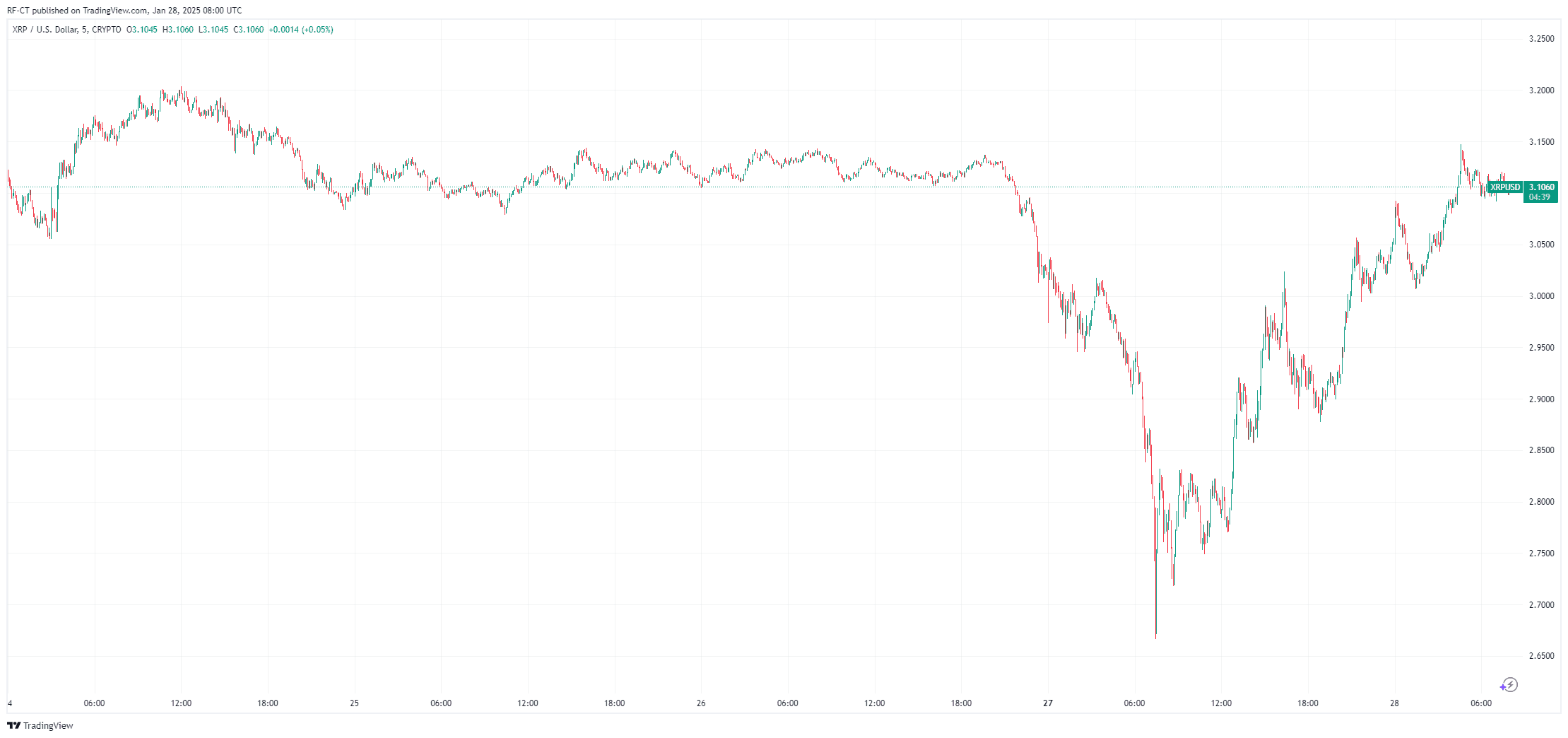Top 3 Reasons why EOS Price is UP Despite the Crypto Market Crash
While Bitcoin and the broader crypto market are under pressure, EOS is showing unexpected strength: The token is currently priced at $0.84, marking a 5% daily gain and an impressive 46% increase over the past week. With a market cap of $1.32 billion, EOS is back on traders’ radars. Although its all-time high of $19 is still far off, the recent surge is catching attention.
EOS/USD 1-day chart - TradingView
What’s behind this pump? Here are the Top 3 reasons why EOS is soaring—despite market uncertainty.
The biggest price driver? EOS is undergoing a major transformation. By the end of May 2025, the project will officially rebrand as Vaulta, shifting its focus to blockchain-powered banking solutions—a hot topic in a market hungry for real-world use cases.
As part of this rebrand, the EOS token will transition into Vaulta, with a new ticker expected to be announced later this April. The core technology remains intact, including integration with exSat, a Bitcoin-based banking solution. This strategic shift is injecting fresh momentum—and clearly driving the price higher.
Vaulta aims to position itself as a top staking option, offering an impressive 17% yield. For comparison, Ethereum currently offers around 2%, and Solana sits at roughly 5%.
These rewards are backed by a staking pool of approximately 250 million Vaulta tokens. In a bearish market, such high yields become particularly attractive to investors—creating a strong incentive to jump in early.
--> Earn on EOS with Bitget staking <--
EOS is also seeing strong activity in the derivatives market. According to CoinGlass, open interest in EOS futures has surged over 30%, reaching an 11-month high of $144.14 million.
Even more interesting: The funding rate has flipped positive, indicating that more traders are now betting on the upside. This signals clear market sentiment—many expect EOS to climb even further in the near term.
While most altcoins are struggling, EOS is gaining momentum—and it’s not just luck. With the upcoming Vaulta rebrand, lucrative staking rewards, and bullish derivatives data, the token has multiple strong narratives supporting its rally. If the crypto market stabilizes, EOS could turn out to be one of 2025’s biggest surprises.
While Bitcoin and the broader crypto market are under pressure, EOS is showing unexpected strength: The token is currently priced at $0.84, marking a 5% daily gain and an impressive 46% increase over the past week. With a market cap of $1.32 billion, EOS is back on traders’ radars. Although its all-time high of $19 is still far off, the recent surge is catching attention.
EOS/USD 1-day chart - TradingView
What’s behind this pump? Here are the Top 3 reasons why EOS is soaring—despite market uncertainty.
The biggest price driver? EOS is undergoing a major transformation. By the end of May 2025, the project will officially rebrand as Vaulta, shifting its focus to blockchain-powered banking solutions—a hot topic in a market hungry for real-world use cases.
As part of this rebrand, the EOS token will transition into Vaulta, with a new ticker expected to be announced later this April. The core technology remains intact, including integration with exSat, a Bitcoin-based banking solution. This strategic shift is injecting fresh momentum—and clearly driving the price higher.
Vaulta aims to position itself as a top staking option, offering an impressive 17% yield. For comparison, Ethereum currently offers around 2%, and Solana sits at roughly 5%.
These rewards are backed by a staking pool of approximately 250 million Vaulta tokens. In a bearish market, such high yields become particularly attractive to investors—creating a strong incentive to jump in early.
--> Earn on EOS with Bitget staking <--
EOS is also seeing strong activity in the derivatives market. According to CoinGlass, open interest in EOS futures has surged over 30%, reaching an 11-month high of $144.14 million.
Even more interesting: The funding rate has flipped positive, indicating that more traders are now betting on the upside. This signals clear market sentiment—many expect EOS to climb even further in the near term.
While most altcoins are struggling, EOS is gaining momentum—and it’s not just luck. With the upcoming Vaulta rebrand, lucrative staking rewards, and bullish derivatives data, the token has multiple strong narratives supporting its rally. If the crypto market stabilizes, EOS could turn out to be one of 2025’s biggest surprises.
Buy SHIB Now or Regret Later? This Chart May Have the Answer!
Shiba Inu (SHIB) , the meme-inspired token turned DeFi and metaverse contender, continues to attract speculative eyes despite its recent decline. After an explosive run in 2021, SHIB's price action has since cooled , hovering near support zones as investors await a catalyst. The latest daily and hourly charts reveal a tight tug-of-war between bears and bulls — but could a breakout be closer than it appears? Let’s dive deep into the current technical structure and what it could mean for SHIB holders in the days ahead.
The daily chart paints a picture of prolonged bearish pressure. SHIB price is currently trading at $0.00001212 , marking a 2.36% decline for the day. More importantly, the price has continued to reject the 50-day Simple Moving Average (SMA) and remains under all key SMAs — the 20, 50, 100, and 200-day — a clear sign of bearish dominance.
The Moving Average Ribbon (SMA Ribbon) reveals a descending alignment, with no sign of crossover, which generally indicates a sustained downtrend. The 200-day SMA at $0.00001912 is especially significant; reclaiming it would mark a major trend reversal. Until then, SHIB remains in a long-term downtrend .
Volume indicators, while not explicitly shown here, correlate with the Accumulation/Distribution Line (ADL), which is flattening and showing a slight decline — implying that whales and smart money are not actively accumulating at current levels. This weak accumulation could mean investors are waiting for a stronger dip or a news-driven catalyst.
--> Click here to Buy SHIB on Bitget <--
Switching to the hourly chart, the picture becomes a bit more nuanced. Shiba Inu Price showed a slight intraday rebound , gaining 0.96% from its previous hourly close. However, this bounce ran into immediate resistance at the 50-hour SMA, currently around $0.00001247, and got rejected. This intraday weakness indicates that short-term bulls lack conviction.
Interestingly, the ADL on the hourly chart is attempting to curl upward after forming a base, suggesting small pockets of accumulation during dips. However, this remains weak and inconsistent. The 200-hour SMA looms above at $0.00001309, which now acts as the critical resistance barrier for any short-term recovery.
Despite the minor price uptick, the SMA Ribbon continues to slope downward — reinforcing the idea that any rallies may be short-lived unless a breakout over the 100-hour and 200-hour SMAs occurs with strong volume.
--> Click here to Buy SHIB on Bitget <--
On the daily timeframe, the Heikin Ashi candles are red and flat-bottomed, confirming a strong bearish trend with no significant wicks to the downside — this implies clean selling pressure without much buying support. Unless SHIB price prints a green Heikin Ashi candle with a higher high and longer upper wick, the trend remains unchanged.
The SMA indicators are stacked bearishly (20 < 50 < 100 < 200), forming a classic downward ribbon. This is a textbook sign of a persistent downtrend with little chance of reversal unless a bullish crossover emerges — particularly the 20-day SMA flipping above the 50-day.
The ADL also reflects more distribution than accumulation, weakening the case for a near-term breakout.
On the hourly chart, while a small bounce occurred, the resistance at the 100-hour and 200-hour SMAs proved too strong. The ADL uptick may indicate a short squeeze or opportunistic buys, but it doesn't suggest a trend reversal just yet.
--> Click here to Buy SHIB on Bitget <--
In the near term, if Shiba Inu price fails to hold support at $0.00001200, it could revisit recent lows near $0.00001150. On the flip side, a clean breakout above $0.00001250 with a strong green Heikin Ashi candle and bullish ADL divergence might push SHIB toward the psychological resistance at $0.00001300.
However, a sustainable uptrend would require SHIB price to break above $0.00001370 (the 100-day SMA) and reclaim $0.00001690 to invalidate the bearish structure and regain bullish momentum.
Right now, Shiba Inu is in no man's land — caught between weak support and strong resistance. The daily trend is decisively bearish, while the hourly chart hints at speculative bounces rather than solid accumulation.
Unless a news catalyst, such as a SHIB ecosystem update or broader crypto rally, injects new volume, it’s likely that Shiba Inu price will continue to drift or drop further. For traders, this is a wait-and-watch zone. For long-term holders, any deeper dip may provide a better accumulation opportunity — but only with risk management in place.
Shiba Inu (SHIB) , the meme-inspired token turned DeFi and metaverse contender, continues to attract speculative eyes despite its recent decline. After an explosive run in 2021, SHIB's price action has since cooled , hovering near support zones as investors await a catalyst. The latest daily and hourly charts reveal a tight tug-of-war between bears and bulls — but could a breakout be closer than it appears? Let’s dive deep into the current technical structure and what it could mean for SHIB holders in the days ahead.
The daily chart paints a picture of prolonged bearish pressure. SHIB price is currently trading at $0.00001212 , marking a 2.36% decline for the day. More importantly, the price has continued to reject the 50-day Simple Moving Average (SMA) and remains under all key SMAs — the 20, 50, 100, and 200-day — a clear sign of bearish dominance.
The Moving Average Ribbon (SMA Ribbon) reveals a descending alignment, with no sign of crossover, which generally indicates a sustained downtrend. The 200-day SMA at $0.00001912 is especially significant; reclaiming it would mark a major trend reversal. Until then, SHIB remains in a long-term downtrend .
Volume indicators, while not explicitly shown here, correlate with the Accumulation/Distribution Line (ADL), which is flattening and showing a slight decline — implying that whales and smart money are not actively accumulating at current levels. This weak accumulation could mean investors are waiting for a stronger dip or a news-driven catalyst.
--> Click here to Buy SHIB on Bitget <--
Switching to the hourly chart, the picture becomes a bit more nuanced. Shiba Inu Price showed a slight intraday rebound , gaining 0.96% from its previous hourly close. However, this bounce ran into immediate resistance at the 50-hour SMA, currently around $0.00001247, and got rejected. This intraday weakness indicates that short-term bulls lack conviction.
Interestingly, the ADL on the hourly chart is attempting to curl upward after forming a base, suggesting small pockets of accumulation during dips. However, this remains weak and inconsistent. The 200-hour SMA looms above at $0.00001309, which now acts as the critical resistance barrier for any short-term recovery.
Despite the minor price uptick, the SMA Ribbon continues to slope downward — reinforcing the idea that any rallies may be short-lived unless a breakout over the 100-hour and 200-hour SMAs occurs with strong volume.
--> Click here to Buy SHIB on Bitget <--
On the daily timeframe, the Heikin Ashi candles are red and flat-bottomed, confirming a strong bearish trend with no significant wicks to the downside — this implies clean selling pressure without much buying support. Unless SHIB price prints a green Heikin Ashi candle with a higher high and longer upper wick, the trend remains unchanged.
The SMA indicators are stacked bearishly (20 < 50 < 100 < 200), forming a classic downward ribbon. This is a textbook sign of a persistent downtrend with little chance of reversal unless a bullish crossover emerges — particularly the 20-day SMA flipping above the 50-day.
The ADL also reflects more distribution than accumulation, weakening the case for a near-term breakout.
On the hourly chart, while a small bounce occurred, the resistance at the 100-hour and 200-hour SMAs proved too strong. The ADL uptick may indicate a short squeeze or opportunistic buys, but it doesn't suggest a trend reversal just yet.
--> Click here to Buy SHIB on Bitget <--
In the near term, if Shiba Inu price fails to hold support at $0.00001200, it could revisit recent lows near $0.00001150. On the flip side, a clean breakout above $0.00001250 with a strong green Heikin Ashi candle and bullish ADL divergence might push SHIB toward the psychological resistance at $0.00001300.
However, a sustainable uptrend would require SHIB price to break above $0.00001370 (the 100-day SMA) and reclaim $0.00001690 to invalidate the bearish structure and regain bullish momentum.
Right now, Shiba Inu is in no man's land — caught between weak support and strong resistance. The daily trend is decisively bearish, while the hourly chart hints at speculative bounces rather than solid accumulation.
Unless a news catalyst, such as a SHIB ecosystem update or broader crypto rally, injects new volume, it’s likely that Shiba Inu price will continue to drift or drop further. For traders, this is a wait-and-watch zone. For long-term holders, any deeper dip may provide a better accumulation opportunity — but only with risk management in place.
Trump's Reciprocal Tariffs Measures
President Trump's announcement of reciprocal tariffs has sparked significant interest and concern globally. The proposed measures aim to address trade deficits and promote fair trade practices, but their impact on the economy and consumers is a pressing concern.
Understanding Reciprocal Tariffs:
Reciprocal tariffs involve equalizing US import tariffs with those imposed by its trading partners. This approach could have substantial implications, particularly if applied to a broader range of foreign taxes, such as value-added taxes and digital services taxes.
Potential Consequences:
The introduction of reciprocal tariffs may lead to:
Increased Costs for Consumers: Higher tariffs could result in increased prices for various goods, including autos and everyday items.
Retaliatory Measures: US trading partners may impose their own tariffs on US goods, potentially escalating into a trade war.
Economic Uncertainty: The impact of tariffs on business confidence and investment decisions could be significant.
Impact on US Trading Partners:
Major US trading partners, including China, the European Union, and Japan, may face
$TRUMP significant tariff rates under the new measures:
China: 34% tariff rate
European Union: 20% tariff rate
Japan: 24% tariff rate
Economic Projections:
According to J.P. Morgan Research, the introduction of reciprocal tariffs could lead to:
Reduced US GDP Growth: Heightened trade policy uncertainty and existing tariffs may weigh on activity growth.
Increased Inflation: Tariffs could push up consumer prices, with potential implications for inflation forecasts.
The introduction of reciprocal tariffs is a complex issue with far-reaching implications. Understanding the potential consequences and impact on various stakeholders is crucial for informed decision-making. As the situation continues to evolve, staying informed about the latest developments and analysis will be essential.


 Lowest price
Lowest price Highest price
Highest price 
















































